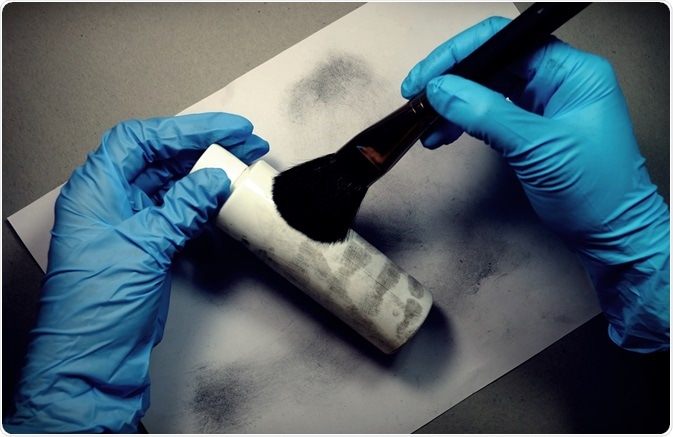Aside from the high-powered forensic human identification advances from DNA profiling, fingerprints remain another powerful type of evidence deposited at crime scenes. Fingerprints can be categorized into three classes; latent prints where the prints are not visible to the naked eye, patent prints which are visible to the naked eye, and molded prints as a result of direct contact with particular materials.

Fingerprints found at a crime scene. Image Credit: Prawitcha Yata/Shutterstock.com
Latent prints are the most challenging fingerprints to process, as attention to prints that are not visible at first are needed to capture what could be a lead to a criminal investigation. A variety of techniques can be used to enhance fingerprints prior to analysis taking place in the crime laboratory.
Detecting fingerprints on paper surfaces
The chemical reagent, ninhydrin, enhances fingerprints by reacting with amino acids present in sweat, giving a dark purple color known as Ruhemann's Purple. The technique involves spraying the evidence with a ninhydrin solution and leaving it for 24 to 48 hours for the prints to fully develop.
Fingerprints treated with ninhydrin can then be treated with cadmium salt or zinc solution to further enhance their appearance. A color change is then observed as a result of this coordination complex, and the print is luminescent under the conditions of low temperature and certain excitations produced from a high-intensity light source.
Another chemical reagent that reacts similarly with amino acids to ninhydrin is the 1,8-diaza-9-fluorenone, or DFO. Nevertheless, the reaction product from this treatment is less pigmented than the product as a result of ninhydrin. However, an advantage that DFO has compared to ninhydrin is that the developed prints are luminescent at room temperature without the need for additional treatment.
It is also important to note that DFO must only be used before and not after treatment with ninhydrin. However, DFO has a disadvantage of its higher cost as an enhancing chemical reagent, its incompatibility with luminescent substrates, and its need for a specific light source.
Physical developer enhances fingerprints on wet porous surfaces
The technique of using a physical developer to enhance fingerprints can be done on wet porous surfaces or developed prints from DFO and ninhydrin processing as an additional treatment to further enhance prints. This physical developer comes in the form of an aqueous solution containing the ferrous/ferric redox system as well as citric acid and silver nitrate, with a surfactant as a stabilizer.
When other enhancement techniques are unsuccessful, a physical developer is usually used. However, a limitation of using this technique is its short shelf life due to its instability and laborious process of sample preparation, as well as application.
Treatment of cyanoacrylate on non-porous surfaces to detect fingerprints
Glass, plastic, and metal are typically considered non-porous surfaces. Prior to any treatment to enhance fingerprints, optical techniques are usually utilized to examine the appearance of these prints. Powdering is a cost-effective technique used on fixed surfaces, regardless of its low sensitivity, and wet powdering is sprayed for wet surfaces.
Aluminum flake powders are known to be the most effective, with magnetic powders being the least destructive tool, and are applied using a magnetic wand. Nevertheless, the sensitivity of magnetic powders can be improved by iron flake powders.
Cyanoacrylate fuming has been a routine technique used for non-porous surfaces for years and the treated prints can be further enhanced by applying a luminescent stain. Vacuum metal deposition can be implemented for older prints on surfaces that impose challenges.
The latent print is treated with cyanoacrylate vapor that results in the formation of a white hard polymer, and the presence of ionic material, as well as moisture of the deposit, catalyzes this polymerization. Nevertheless, contrast can be an issue from using cyanoacrylate fuming, and, therefore, the use of a luminescent stain or a powder is recommended to enhance the developed prints.
Amido black used to enhance fingerprints contaminated with blood
The Police Scientific Development Branch suggested the use of amido black in methanol or water-based formulations to enhance fingerprints contaminated in blood. Methanol-based amido black formula has the advantages of its cost-effectiveness as well as its easy application to give defined finger ridge enhancement with little background staining. Whereas the water-based formula is cost-effective, easy to use, as well as non-toxic, and non-flammable, which makes it a safer formula to use both at the crime scene and the crime laboratory.
The procedure of amido black aqueous-based solution treatment begins with immersing the print evidence in an appropriate amount of the fixing solution for five to six minutes, then discarding the solution. The water-based working solution is poured into the print evidence to fully immerse the evidence for three to four minutes.
The evidence is then placed in a container filled with distilled water, rocking the container until excess dye is removed from the background to visualize the contrast of the fingerprints with the background. The print evidence is allowed to dry at room temperature and then photographed for examination.
Sources:
- Lennard, C., 2001, October. The detection and enhancement of latent fingerprints. In 13th INTERPOL Forensic Science Symposium, Lyon, France (pp. D2-88). US Department of Justice.
- Ricciuti, E 2007, Science 101: Forensics, 1st edn, HarperCollins, New York.
- Sears, V.G. and Prizeman, T.M., 2000. Enhancement of fingerprints in blood--part 1: The optimization of amido black. Journal of Forensic Identification, 50(5), p.470.
Further Reading
Last Updated: Jul 13, 2021